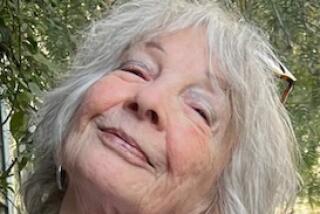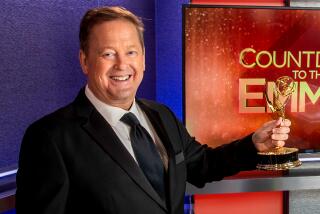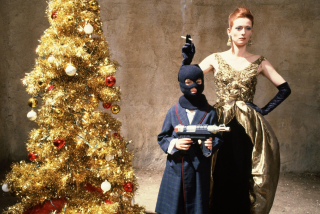Review: ‘Barbara Rubin & the Exploding NY Underground’ profiles provocateur
- Share via
The fascinating documentary “Barbara Rubin & the Exploding NY Underground,” chronicles the brief, fleetingly influential and puzzling life of one of the few female creators in New York’s male-dominated, 1960s avant-garde film movement.
Director-producer-editor Chuck Smith deserves kudos for exhuming the spirit of this complex, contradictory, largely forgotten soul. As critic J. Hoberman declares here, “She was like the Joan of Arc of Underground Cinema.” Overstatement? Read on.
The vivid documentary, which contains a wealth of often rare archival and personal footage and photos, involvingly outlines how as a teen, Queens, N.Y., native Rubin was “put away” (in a mental hospital) by her parents as a reaction to her wild streak. Soon after, at 17, she fortuitously began working for now-legendary experimental filmmaker and Film-Makers’ Cooperative co-founder Jonas Mekas.
Through the Cooperative, Rubin met and bonded with such artistic pioneers as Allen Ginsberg, Andy Warhol and Jack Smith, whose shock-worthy 1963 erotic movie “Flaming Creatures” was banned in the U.S.
But Rubin, undoubtedly inspired by the taboo “Creatures,” was just 18 when she starting shooting her own subversive film, the genitalia-centric “Christmas on Earth.”
Smith incorporates startling clips here from Rubin’s wildly outré short, which depicted an intrepid, painted-and-masked cast performing gay and straight sex acts. The 29-minute movie was also unique for how it was presented: Its two separate reels were projected at once, one image inside the other.
A few underground screenings aside, the orgiastic film was deemed too explicit for public showings but remains a seminal entry in the history of queer and feminist cinema.
What drove Rubin to make such a boundary-busting piece? Perhaps as one of the documentary’s many interviewees notes: “She thought the act of filming something could change the world.”
But the hyper-radical nature of her mini-oeuvre (she made only a few films, some of which are lost) certainly affected what Rubin could — or maybe even wanted to — accomplish cinematically. Still, the documentary features a letter she wrote to Walt Disney, of all people, pitching an ambitious, star-studded sequel to “Christmas.” Practicality clearly wasn’t her strong suit.
But the muse-like Rubin had vision and she excelled at engineering meetings between “people she thought were remarkable” for creative synergy. She introduced Warhol to the Velvet Underground as well as to her collaborator-lover Bob Dylan. She also connected Dylan with her close friend Ginsberg. (Although Ginsberg was gay, Rubin wanted to have his child — again, not practical.)
In addition, she helped Warhol create his legendary Exploding Plastic Inevitable multimedia shows. And in 1965, Rubin organized a major international London poetry reading starring Ginsberg and other Beat Generation notables.
But in 1967, Rubin’s art-sex-and-drug-fueled life took a 180-degree turn when she persuaded Ginsberg to buy an upstate New York farm as a kind of refuge/DIY rehab center for poets. Though the experiment failed, Rubin became drawn to the area’s ultra-Orthodox Jewish population and left to learn about — and later join — the deeply rigid sect.
To say that Rubin’s friends and peers, who knew her as a nonconformist and feminist, were shocked by her conversion is an understatement. But she was always nothing if not unpredictable.
Two Hasidic marriages later, Rubin died, in 1980, of complications after delivering her fifth child.
Mekas, who died in January at 96, was one of Rubin’s closest allies and a catalogist of her writings and film footage. He even kept a box with Ginsberg’s beard (an unusual image in a film that’s full of them), which was shaven off at Rubin’s behest.
Although Mekas is interviewed extensively here, he can shed only so much light on the elusive Rubin and her true psychological makeup. The same goes for the array of critics, friends, artists and other observers who intriguingly weigh in on Rubin, her creative heyday and singular persona.
Unfortunately, aside from a few short chats with Rubin’s aunt and cousin, the documentary excludes input from other family members as well as any mention of how — or if — Rubin’s parents fit into her life after she left home for Manhattan.
According to Smith, her parents and schizophrenic older brother died long ago. In addition, he says her children, though supportive of the film, declined to be interviewed to respect the wishes of their father — Rubin’s second husband — a renowned rabbi in Israel.
Nonetheless, Smith has crafted a visually and artistically compelling portrait about a distinctive figure in a pivotal and exciting time.
-------------
‘Barbara Rubin & the Exploding NY Underground’
Not rated
Running time: 1 hour, 18 minutes
Playing: Starts June 14, Laemmle Music Hall, Beverly Hills; June 17 and June 18 only at Laemmle Royal, West Los Angeles; Laemmle Town Center 5, Encino; Laemmle Playhouse 7, Pasadena; Laemmle Claremont
------------
More to Read
Only good movies
Get the Indie Focus newsletter, Mark Olsen's weekly guide to the world of cinema.
You may occasionally receive promotional content from the Los Angeles Times.









